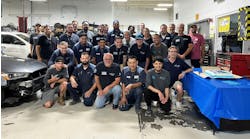The latest paint prep products and equipment will add speed, ease and quality to your work
These new tools and techniques are able to provide an even more flow-free paint prep than before. As we transition into waterborne basecoat applications, which some paint manufacturers warn must have a "flow-less prep," these tools will help us to achieve the needed prep fast. Lets look at the latest and greatest prep tools and tips.
Rolled primer
Some techniques have a large learning curve. Many technicians decide that if they don't or can't make one work in just a few tries, they will abandon that technique for fear of losing time and productivity. A good example of a new technique – one used in Europe which has never been adopted widely in the United States – is rolled priming. Rolled priming, especially rolled epoxy primer for corrosion protection, can be performed in a body repair stall with little or no masking, no overspray and little cleanup. The roll applicator can be sealed in a bag (see Fig. 1) and used all day on multiple jobs. Corrosion protection and bare metal undercoating can be applied and cured prior to the arrival of the vehicle in the paint shop, allowing you to complete one of the first steps of paint preparation. Because some epoxy paints have long pot lives (one has a pot life of 12 hours at 70 degrees F.), they can be mixed in the morning and used all day. The dry times can be long, up to 60 minutes for a film thickness of 2.0 to 2.2 in one case. If they're applied in the body shop prior to the vehicle being moved to the paint shop, what seemed to be a very long dry time is no longer significant. Also, when applied in the body shop, the primer can be applied prior to application of body fillers or putty, providing greater corrosion protection for the repair.Dry D/A blocking
Let me admit that this technique took a while to try and even a bit longer for me to accept. For years, I thought that those who tried to block with a dual action (D/A) sander were simply technicians who were less concerned about a quality finish then I was. I believed that it was impossible to make a non-wavy, smooth flat finish without blocking by hand – wet. In fact, in cases where I was more concerned than usual about getting a show-quality finish, I would paint-stick block the primer with a sprayed-on guide coat. This could still be the case today, if some significant changes had not arrived – changes such as improved D/As, interface pads, dry guide coat, and body filler and glaze application guns having little to no cleanup (see Fig. 3).Choosing a D/A for prep
D/As come with different handles and with different sanding pattern sizes. Though they may all look similar, some have larger orbital patterns than others. The ones with the largest patterns generally have a more aggressive cut, and though most can be purchased as a "palm" type, some can still be purchased with handles. Generally speaking, though, it is not the handle type that determines how aggressive a cut a D/A has. It is the size of the orbital pattern. Typically, the larger the sanding pattern is, the more aggressive the D/A is. If your D/A does not have the sanding pattern size, such as 3/8th, 3/16th or 3/32 in., as an example, or is marked as a fine or finish D/A, you can test the pattern size by placing a piece of paper on it and lightly touching a pencil to it as the D/A runs freely (see Fig. 4).D/As made specifically for painters have a smoother operating path and tighter pattern and are suited for power prep or dry blocking. You'll also want to note that as environmental laws change and more regions mandate the removal of drains in shops, wet sanding may become more difficult. Thus dry sanding with vacuum pickup or sanding in prep decks may become a paint shop's only option.
Soft pads
These pads fit between the D/A pad and the paper. They also make the cutting action of the D/A less aggressive over high crowns. If a technician does not use pads like these, it is more likely that a cut-through over the high crowns will be produced. These pads keep the surface of the sandpaper cooler, which extends the life of the pad, especially on finer grit paper. With the use of a guide coat, a D/A and pad quickly sands smooth areas over featheredged surfaces, as well as over body filler. If imperfections such as sand scratches or contour mapping are present, they can be quickly detected. The continued blocking can be concentrated on the area until it is corrected. Following the first sanding, a second guide coat can be applied and a finer sanding can quickly be performed to assure all scratches are removed and the proper grit finish is produced.Dry guide coat
Though guide coats have been around for many years, they have not been widely used. Sprayed-on guide coats take time to mix, spray, dry and be cleaned up afterward. Even when an aerosol spray can was used, it needed time to dry and would load up the sandpaper quickly. Thus, many technicians didn't use it. Dry guide coats (see Fig. 5), though, can be quickly applied and immediately sanded with no appreciable increase of paper loading. This new convenience virtually eliminates any reason not to use a guide coat. Guide coats quickly and visually reveal any imperfections in the repair, so even a novice technician can know when the surface is properly prepared (see Fig. 6).Glaze and body filler application guns
Some of the newest tools that speed up the prep and body filling process are body filler application guns. These guns dispense fully mixed body filler or glazing putty directly where it is needed and in the exact amount needed (see Fig. 7). The air power drives the plunger to apply the filler at the required speed and also spins the mixing device inside the tube with no contact to the outside air, virtually eliminating air bubbles that cause pinholes. The correct ratio of body filler and hardener is applied each time, so the risk of over- or under-canalization is virtually eliminated.Perhaps the body filler gun's best attribute is its ease of clean-up. There is no mixing board to either buy or cleanup. There is little or no excess filler to get rid of. The gun leaves no filler on your gloves or all over your spreader from overzealous mixing. Just a quick swipe with a cloth, and the spreader is clean and ready for the next use. The used application tip can be left in place until it hardens. You can quickly replace it before the gun's next use, virtually eliminating all gun clean-up time.
Prep carts
If a prep technician rolls up to a new job with a prep cart (see Fig. 9) loaded with all the tools and materials needed for the job and with a clear work plan for that job, the prep time can be significantly reduced. Good planning eliminates wasted time and materials and can virtually eliminate paint flaws due to poor prep.What's right for you?
You can produce the needed flawless surface in a shorter amount of time with the use of rolled primer, finish D/A, dry guide coat, and fast and clean application of glaze. In fact, if the body technicians either significantly reduce or eliminate pinholes by mixing body filler without air bubbles and use dry guide coat when sanding body filler (thus making it flatter and smoother), glaze may not be needed as much in the paint department to prepare the surface for refinishing. Though all the latest tools and techniques may not be for you or your shop, some may speed up your prep time and increase your shop's throughput. Give them a try.



